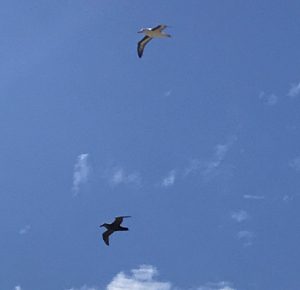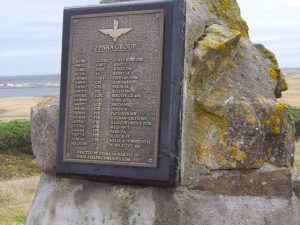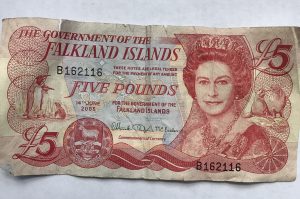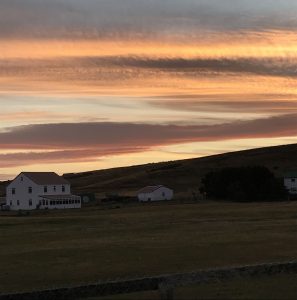The Falklands Fac-Tour
Stuart Higgins has lived in Teddington with his family for over 30 years and is a former Editor of The Sun. He is now a PR consultant offering expert advice in crisis management as well as promoting brands and people. He is also Chairman of SporTedd – a local initiative to support community sport projects. (www. sportedd.co.uk)

Bushy Park and Richmond Park have always been perfectly fulfilling in their offerings of wildlife, the deer, the parakeets, the herons and the eye-catching colours of the varying seasons.
Then, I travelled 8000 miles to the Falkland Islands, one of the world’s most remote regions in the South Atlantic with its constant wind and tree-less landscape.
In this enticing land there is a fascinating collision between life and death, equally mesmerising for the most ardent of ornithologists and the military historian, perhaps hooked on the detail of the 1982 conflict fought on the rightful ownership of the islands between Britain and Argentina.
The islands, which only has a population of 3000 plus a military garrison and support staff of 2000 is the gateway to the Antarctic, where four seasons in a day can play havoc with your clothing choices. Your travel plans may be disrupted, especially if you are depending on the light, bright red eight-seater planes, which hop at low levels, between islands, occasionally offering up spectacular views of the local marine life, which includes Commerson’s and Peale’s dolphins and the Sei and Minky whales.
We travelled from RAF Brize Norton, Oxfordshire in a giant grey A330 Air Tanker, which takes 18 hours with a three hour refuelling stop at Cape Verde instead of the usual and traditional stop at Ascension Island, where the runway is being repaired. The flight is full of troops returning to their deployment as well as a small number of returning Falklanders and tourists. It’s a long-haul and you will need more than one long book!
This is the territory, just 600 miles from South Georgia in the Antarctic, where the wind howls and the sun burns in the same hour, yet the five species of penguins, the majestic King penguins, the ring-necked Magellanic, the Rock Hoppers, the Gentoo and Macaroni stand statue-like in their colonies, huddled together in their distinctive and different ‘uniforms’ unruffled by the 40-50mph wind in the white sand dunes edging the Caribbean-blue South Atlantic.

For even the casual bird-lover there is an abundance of rich observation opportunities with the giant black-browed albatrosses, known locally as Mollymawks, the rare and endangered but surprisingly tame striated caracara or Johnny Rooks, the thousands of predatory skuas hovering menacingly over the black and white platoons of the Imperial Cormorants, as well as hundreds of other birds like the Snipe, the Snowy Sheathbill, the Sooty Shearwater, Cobb’s Wren and the Variable Hawk. It is estimated there are 205 different species of birds across the 750 islands, which make up the Falklands.

The scenery of seemingly endless expanses of craggy quartzine rock and often bleak moorland resemble Dartmoor and Scotland and the openness of Mount Harriet, Mount Longdon and Tumbledown – – all familiar battle names from 1982 – are still punctured with manmade rocky dugouts for the Argentine frontline soldiers as well as the twisted debris of mortars and aircraft wreckage. They represent a formidable landscape for the conflict, which claimed the lives of 255 British military personnel, 649 Argentinians and three Falklanders over the 74 day conflict, often in close combat situations with fixed bayonets.

The rusty remnants from the conflict 37 years ago still sit on the windswept hills of Pebble Island including an ejector seat from an Argentine Dagger aircraft, an engine and the distinctive camouflage coloured wings of a downed jet, complete with its identity number. They appear as forlorn ‘monuments’ to the war just a wingbeat from the vibrant wildlife, which fights for its own survival in this remote region.
There are numerous memorial crosses and stone cairns including one which marks the spot where Lieutenant Colonel ‘H’ Jones, VC, OBE Commander of the 2nd Battalion, Parachute Regiment, was shot and killed, aged 42 in the battle for Goose Green on May 30th 1982 and his gravestone sits amongst others at the beautiful and pristine Blue Beach Cemetery overlooking San Carlos Bay. A poignant tribute from Col. H’s grandson Henry reads: “If Carlsberg made grandfathers.” Another cemetery nearby full of white crosses marks the graves of Argentinian soldiers.
Chance encounters with those caught up in the war are inevitable, whether it’s a teacher like Andrew Clarke, visiting for the seventh time from the UK and who was detained in the Goose Green Community Hall for 29 days with 114 others including children with meagre supplies of beans, cream crackers and marmite. Or hero pilot, Flight Lieutenant David Morgan, holder of the Distinguished Service Cross (DSC) who was the last person to shoot down an enemy aircraft in the 1982 conflict.
There are also various quaint customs which are unique to this region including a Smoko, which means a tea break or snack break. The term was originally used by sheep-shearers for a cigarette break and often includes home-made cakes or scones which come with jam from the indigenous diddle-dee berry, which is prolific across the islands and much-loved by the non-predatory birds of the islands. The islands also have their own currency, which is not useable in the UK and its own weekly newspaper, called, of course, The Penguin News!

True, it is a long way from the Diana Fountain in Bushy Park but if you have an adventurous streak in you with an itchy thread of curiosity about wildlife as well as an interest in the mysterious and faraway land the then Prime Minister Lady Thatcher fought to defend all those years ago, then get packing today before the discovery of oil and use of natural energy like the wind and the sun turned the Falklands into the next Easyjet route and a boomtown on the other side of the world!

For more information on flights and accommodation please see:
